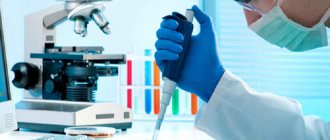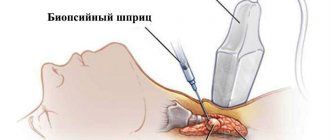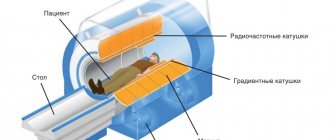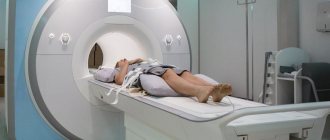One of the most important things your doctor will ask you to do is get blood tests to find out if you have hyperthyroidism. Blood tests are important in determining whether your thyroid is causing your bothersome symptoms. This is a relatively simple process, but interpreting the results can be challenging.
Symptoms of thyrotoxicosis (hyperthyroidism)
Many patients have a pronounced characteristic set of symptoms of thyrotoxicosis:
- anxiety;
- emotional instability;
- weakness;
- tremor (shaking) of the limbs;
- cardiopalmus;
- increased sensitivity to heat;
- sweating;
- weight loss with normal or increased appetite.
The following manifestations are also possible: frequent urination, menstrual irregularities (oligomenorrhea or amenorrhea) in women, gynecomastia and erectile dysfunction in men.
Patients with less severe hyperthyroidism or older people often have symptoms related to one or more organs or systems.
Isolated signs, in the presence of which hyperthyroidism should be diagnosed:
- unexplained weight loss;
- arrhythmia;
- myopathy;
- menstrual irregularities;
- gynecomastia.
Other conditions that may suggest hyperthyroidism:
- osteoporosis;
- hypercalcemia;
- arrhythmias;
- breathing problems;
- worsening glycemic status in patients with diabetes.
In elderly patients, cardiopulmonary symptoms such as tachycardia, arrhythmia, dyspnea on exertion, and edema may predominate. There is also a trend toward greater weight loss with less increase in appetite. In some patients, the only symptoms are weakness and asthenia.
Prevention and treatment
Of course, iodine is necessary for the full functioning of the thyroid gland. Since the body is not able to synthesize this element, it must be obtained through food. A typical meal per day contains 100-200 mg of iodine. This amount is sufficient for the proper functioning of the thyroid gland.
The diet is about limiting fat. The fat consumed should come from vegetable oils and not exceed 70 g per day. It is also recommended to avoid animal products, such as smoked meats, canned food, bacon, and fat.
Products with a low glycemic index are especially recommended: grain products, milk and dairy products, fish, eggs.
The need for vitamins and minerals increases, especially vitamins A, C, B1 and calcium. Therefore, parsley, dill, carrots, tomatoes, red bell peppers, broccoli, spinach, strawberries, peaches, apricots, oranges and lemons should appear on our plate.
Empty calories such as chips, salty sticks, etc. should be avoided. But fruit jellies, purees and fruit salads are shown.
One of the manifestations of hyperfunction of the thyroid gland is the appearance of a feeling of heat, hot flashes, especially during menopause, so you should not eat excessively hot foods, especially soups, or warm drinks. Coffee and tea are contraindicated, since caffeine negatively affects blood circulation and the nervous system (!) Foods that can stimulate goiter growth, such as turnips, cabbage, soybeans, mustard, and ground nuts, should be avoided.
Hyperthyroidism of the thyroid gland, depending on the cause of its occurrence, can be treated with medications that inhibit the function of the thyroid gland (thyreostatics, iodine) or surgically by removing a node or a significant part of the goiter.
We have reviewed the main symptoms and treatment of thyroid hyperthyroidism, but for more detailed advice you still need to consult an endocrinologist!
(c) Aleynikova Alla Ivanovna.
Examination and physical examination
When examining and auscultating a patient with hyperthyroidism, you can find:
- skin is usually moist and hot to the touch;
- tachycardia;
- possible arrhythmia (irregular pulse);
- possible systolic hypertension (increased systolic pressure);
- tremor (shaking) of the limbs;
- increased reflexes;
- weakness of the muscles of the limbs;
- exophthalmos, periorbital edema, limited mobility of the eyeball - symptoms of Graves' disease - an autoimmune disease of the thyroid gland with hyperthyroidism.
Causes
Hyperthyroidism can occur for a variety of reasons. Hyperthyroidism can be primary, secondary and tertiary.
Among the main factors that contribute to the appearance of primary hyperthyroidism:
- Congenital or acquired lesions of the thyroid gland - inflammation, iodine deficiency or excess.
- Diseases of an autoimmune nature (due to improper functioning of the immune system). With them, antibodies to thyroid cells appear in the body. Autoimmune Hashimoto's thyroiditis and Basedow's disease occur, and triiodothyronine production increases.
- Nodular goiter, adenoma - the appearance of compactions and tumors in the tissues of the gland.
- Inflammation of the thyroid gland - thyroiditis, in which its follicles are destroyed, and the hormones from them enter the blood.
Secondary hyperthyroidism is a consequence of a decrease in the level of thyroid-stimulating hormone (TSH) due to disorders in the pituitary gland. TSH stimulates the activity of the thyroid gland, so there may be an increase in the functionality of a healthy thyroid gland due to the pituitary gland.
Tertiary hyperthyroidism is caused by malfunctions in the hypothalamus and a decrease in its functioning.
Hyperthyroidism is more common in people with a genetic predisposition to endocrine diseases. Women get sick more often than men. Risk factors include living in an endemic area (with iodine deficiency), polluted environmental conditions, and frequent stress.
Enlarged thyroid gland. Palpation of the thyroid gland
The presence or absence of a goiter depends on the condition that caused hyperthyroidism:
- enlargement of the thyroid gland from slight to giant is observed in patients with Graves' disease or toxic multinodular goiter, while in elderly patients with Graves' disease the thyroid gland may not be palpable;
- patients with painless thyroiditis may have a non-enlarged or slightly enlarged thyroid gland;
- a single node may suggest a thyroid adenoma;
- The thyroid gland is sensitive and painful in subacute thyroiditis.
Hyperthyroidism in adults
According to statistics, hyperthyroidism most often develops in men and women between the ages of 20 and 50 years. Both young and elderly people are equally susceptible to the disease. It all depends on the state of the body as a whole and hormonal levels in particular, the presence of concomitant diseases and many other factors. No less significant for the development of the disease may be a hereditary predisposition to it.
Hyperthyroidism in women
Representatives of the fairer sex are more prone to developing this disease. Statistics say that hyperthyroidism occurs about 10 times more often in women than in men. The reason for this is constant hormonal fluctuations in the female body, which haunt them throughout their lives. Menstruation, pregnancy, childbirth and lactation, menopause - all this makes the female body more susceptible to various hormonal imbalances. The thyroid gland is one of the first to suffer.
Women are advised to regularly visit an endocrinologist, examine the thyroid gland through ultrasound diagnostics and take tests for thyroid hormones. So, up to the age of 30, women are recommended to do this once every 5 years, once every 3 years, women aged 30-45 years should undergo a thyroid gland examination, and after 45 years, an endocrinologist should be visited annually.
Hyperthyroidism during pregnancy
Hemorrhoids kill the patient in 79% of cases
During the period of bearing a baby, keeping the thyroid condition under control is extremely important. It is quite possible to become pregnant with hyperthyroidism, because unlike hypothyroidism, its moderate hyperfunction is not always accompanied by a decrease in fertility. Hyperthyroidism during pregnancy without proper treatment and medical supervision poses a particular danger not only to the woman’s health, but also to the life of her child.
Thyroid hormones are most important for the full formation and development of the fetus. Normal levels of thyroid hormones are a necessary condition for normal conception and bearing a child. Their increased secretion negatively affects the health of the mother and child. A stable increase in the level of thyroid hormones causes disruptions in the functioning of the entire body. Hyperthyroidism during pregnancy can cause disturbances in the formation and functioning of the endocrine organ in the developing fetus, the development of goiter, damage to the nervous system and various diseases that threaten not only the health, but also the life of the unborn child.
Hyperthyroidism during pregnancy significantly increases the likelihood of miscarriage, fetal growth restriction, and stillbirth. To reduce the risk of developing hyperthyroidism during pregnancy and avoid all the consequences of this disease, it is necessary to regularly visit an endocrinologist, both when planning conception and at all stages of gestation.
Hyperthyroidism in men
Men, as noted earlier, are less susceptible to developing hyperthyroidism. In addition, subclinical cases of the disease are much more common in representatives of the stronger sex. Both of these causes late diagnosis of hyperthyroidism in men, when the effectiveness of conservative and surgical treatment is close to zero.
Hyperthyroidism in men primarily affects the functioning of the reproductive system. An increase in the level of thyroid hormones leads to an increase in the concentration of SSSG (sex steroid-binding globulin) or, as it is also called, SHBG (a protein that binds male sex hormones). All this causes a decrease in the number of active forms of testosterone and dihydrotestosterone, and as a result, changes in sperm quality and a decrease in sexual performance.
Blood tests for thyroid hormones
Basic tests to assess thyroid function: TSH, T4 free and total, T3 free and total. If necessary, other tests are prescribed. See "Thyroid Exam"
- decrease in TSH level; the degree of gland dysfunction is not assessed by the TSH level alone;
- with obvious hyperthyroidism, an increase in thyroid hormones is also observed - total T3 and total T4, free T3 and free T4;
- some patients show an isolated increase in T4 or T3;
- in subclinical hyperthyroidism, the TSH level is below reference values (usually above 0.05 mIU/l), and total T3 and T4, free T3 and free T4 are within normal limits.
What to do if you suspect hyperthyroidism
Biochemical examination of urine
With hyperthyroidism, there is an increase in the concentration of urea, creatine, and calcium in the urine.
General blood analysis
In hyperthyroidism, mean platelet volume (MPV) is elevated.
Blood test for glycosylated hemoglobin (HbA1c)
With hyperthyroidism, an increase in HbA1c concentration is observed.
Blood test for lipid profile
With hyperthyroidism, cholesterol levels are reduced. In hyperthyroidism, LDL cholesterol levels decrease. In hyperthyroidism, triglyceride levels decrease.
Blood test for markers of osteoporosis
In hyperthyroidism, the concentration of deoxypyridonoline is increased.
Changes in other tests for thyrotoxicosis (hyperthyroidism)
In addition to changes in the level of hormones of the pituitary gland and thyroid gland, nonspecific changes can be detected in other organs and systems. For example, with thyrotoxicosis there is a tendency for HDL, LDL and total cholesterol to decrease, increasing after the start of treatment.
The general blood test may also change - the number of red blood cells - erythrocytes - increases, but the volume of circulating plasma increases more significantly, due to which the blood is diluted, so-called normochromic normocytic anemia occurs.
Alkaline phosphatase and osteocalcin levels may be increased, indicating increased bone metabolism.
All necessary and accessible diagnostic methods
- A laboratory blood test to measure hormone levels (TSH).
For reliable results, 3 days before blood sampling, heavy physical activity, alcohol consumption, nicotine consumption and, if possible, medications are excluded. The last meal before the test should be no later than 12 hours. Blood serum is examined. The limit value for an adult is 4.0 mU/l.
- Immunological analysis for antibodies.
- Ultrasound, which reveals the presence and number of nodes, the exact size and structure of the thyroid gland.
- Electrocardiography. Detects accompanying abnormalities in the functioning of the heart characteristic of thyrotoxicosis.
- Computed tomography and MRI of the thyroid gland. It is prescribed when ultrasound results do not fully clarify the situation.
The procedure is strictly contraindicated for women during pregnancy and patients with pacemakers, implants and metal-ceramic prostheses.
- Scintigraphy (scanning the gland using radioactive iodine or technetium). Determines structural and functional changes. The gamma camera visualizes accumulations of isotopes, thanks to which the doctor can easily detect areas with increased and decreased production of hormones.
- Aspiration biopsy. Necessary for timely diagnosis of malignant nodes. It is not possible to provide high-quality treatment without high-quality fine-needle biopsy.
Each of the above methods is prescribed by a qualified specialist strictly as needed and based on the results of a particular preliminary examination.
Low TSH without hyperthyroidism
In some cases, a low TSH level does not mean hyperthyroidism:
- central hypothyroidism – low TSH levels and normal or decreased T4 and T3 levels;
- non-thyroid diseases, especially in diseases in which patients receive high doses of glucocorticoids or dopamine, may be accompanied by low TSH and reduced free T4, T3;
- recovery from treatment of hyperthyroidism: serum TSH concentrations may remain low for several months after normalization of thyroxine and triiodothyronine levels;
- physiological decrease in TSH during pregnancy;
How to treat hyperthyroidism
Medications
Antithyroid drugs, such as methimazole (Tapazole), stop the production of thyroid hormones. This is basic treatment.
Radioactive iodine
More than 70% of adults with hyperthyroidism receive radioactive iodine. This substance effectively destroys cells that produce hormones. Common side effects from this treatment include dry mouth, dry eyes, sore throat, and changes in taste. For a short period of time after treatment, precautions should be taken to prevent the radiation from spreading to other people.
Interpretation of thyroid tests
| TSH | T3 | T4 | Presumable diagnosis |
| Short | High | Normal |
|
| Short | Normal | High |
|
| Normal or high | High | High |
|
Tags:
TSH, thyroid gland, hyperthyroidism, thyrotoxicosis, thyroiditis, pituitary tumors, Graves' disease
Back to section
general description
Hyperthyroidism (thyrotoxicosis) is a clinical syndrome caused by increased hormonal activity of the thyroid gland and characterized by excessive production of thyroid hormones - T3 (thyroxine) and T4 (triiodothyronine).
Excess thyroid hormones in hyperthyroidism leads to increased oxygen consumption by body tissues. As a result, changes in heat and energy metabolism occur, hormonal balance is disrupted, and adrenal insufficiency develops, which is responsible for adapting the body to stress and regulating metabolism.
Causes:
- Graves' disease (diffuse toxic goiter).
- Plummer's disease (nodular toxic goiter).
- Subacute thyroiditis.
- Artificial hyperthyroidism: occurs when excessive, uncontrolled intake of thyroid hormone.
- Pituitary tumors.
There are several forms of primary hyperthyroidism:
- subclinical (T4 level is normal, TSH is low, asymptomatic);
- manifest, or obvious (T4 level is increased, TSH is significantly reduced, characteristic symptoms are observed);
- complicated (atrial fibrillation, cardiac or adrenal insufficiency, dystrophy of parenchymal organs, psychoses, severe weight deficiency, etc.).











